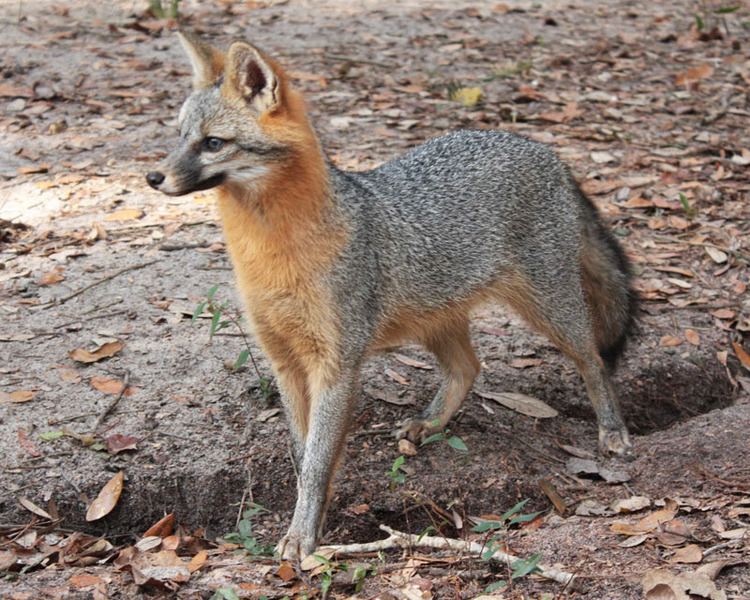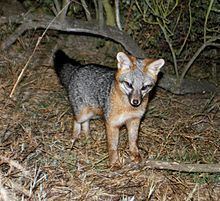Rank Species | Phylum Chordata Higher classification Urocyon | |
 | ||
Similar | ||
Creature feature gray fox
The gray fox (Urocyon cinereoargenteus), or grey fox, is a carnivorous mammal of the family Canidae ranging throughout most of the southern half of North America from southern Canada to the northern part of South America (Venezuela and Colombia). No other canid's natural range spans both North and South America and it is the only American canid that can climb trees. This species and its only congener, the diminutive Channel Island fox (Urocyon littoralis), are the only living members of the genus Urocyon, which is considered to be the most basal of the living canids. Though it was once the most common fox in the eastern United States, and still is found there, human advancement and deforestation allowed the red fox to become more dominant. The Pacific States still have the gray fox as a dominant. Its specific epithet cinereoargenteus means "ashen silver".
Contents
- Creature feature gray fox
- Cool critters gray fox kqed quest
- Origin and genetics
- Description and behavior
- Reproduction
- Diet
- Subspecies
- Parasites
- References

Cool critters gray fox kqed quest
Origin and genetics

The gray fox appeared in North America during the mid-Pliocene epoch 3.6 million years ago (AEO) with the first fossil evidence found at the lower 111 Ranch site, Graham County, Arizona with contemporary mammals like the giant sloth, the elephant-like Cuvieronius, the large-headed llama, and the early small horses of Nannippus and Equus. Genetic analyses of the fox-like canids confirmed that the gray fox is a distinct genus from the red foxes (Vulpes spp.). Genetically, the gray fox often clusters with two other ancient lineages, the east Asian raccoon dog (Nyctereutes procyonoides) and the African bat-eared fox (Otocyon megalotis). Chromosome number is 2n=66. Faunal remains at two northern California cave sites confirm the presence of the gray fox during the late Pleistocene. Genetic analysis has shown that the gray fox migrated into the northeastern United States post-Pleistocene in association with the Medieval Climate Anomaly warming trend. Recent mitochondrial genetic studies suggests divergence of North American eastern and western gray foxes in the Irvingtonian mid-Pleistocene into separate sister taxa.

The gray fox's dwarf relative, the Channel Island fox, is likely descended from mainland gray foxes. These foxes apparently were transported by humans to the islands and from island to island, and are descended from a minimum of 3–4 matrilineal founders.
Description and behavior

The gray fox is mainly distinguished from most other canids by its grizzled upper parts, black-tipped tail and strong neck, while the skull can be easily distinguished from all other North American canids by its widely separated temporal ridges that form a U-shape. There is little sexual dimorphism, save for the females being slightly smaller than males. The gray fox ranges from 76 to 112.5 cm (29.9 to 44.3 in) in total length. The tail measures 27.5 to 44.3 cm (10.8 to 17.4 in) of that length and its hind feet measure 100 to 150 mm (3.9 to 5.9 in). The gray fox typically weighs 3.6 to 7 kg (7.9 to 15.4 lb), though exceptionally can weigh as much as 9 kg (20 lb). It is readily differentiated from the red fox by the lack of "black stockings" that stand out on the latter and the stripe of black hair that runs along the middle of the tail. In contrast to all Vulpes and related (Arctic and fennec) foxes, the gray fox has oval (instead of slit-like) pupils.

The gray fox's ability to climb trees is shared only with the Asian raccoon dog among canids. Its strong, hooked claws allow it to scramble up trees to escape many predators, such as the domestic dog or the coyote, or to reach tree-bound or arboreal food sources. It can climb branchless, vertical trunks to heights of 18 meters and jump from branch to branch. It descends primarily by jumping from branch to branch, or by descending slowly backwards as a domestic cat would do. The gray fox is nocturnal or crepuscular and makes its den in hollow trees, stumps or appropriated burrows during the day. Such gray fox tree dens may be located 30 ft above the ground. Prior to European colonization of North America, the red fox was found primarily in boreal forest and the gray fox in deciduous forest, but now the red fox is dominant in most of the eastern United States since they are the more adaptable species to development and urbanization. In areas where both red and gray foxes exist, the gray fox is dominant.
Reproduction

The gray fox is monogamous. The breeding season of the gray fox varies geographically; in Michigan, the gray fox mates in early March, in Alabama, breeding peaks occur in February. The gestation period lasts approximately 53 days. Litter size ranges from 1 to 7. Kits begin to hunt with their parents at the age of 3 months. By the time that they are four months old, the kits will have developed their permanent dentition and can now easily forage on their own. The family group remains together until the autumn, when the young reach sexual maturity, then they disperse.
Diet
The gray fox is an omnivorous, solitary hunter. It frequently preys on the eastern cottontail (Sylvilagus floridanus) in the eastern U.S., though it will readily catch voles, shrews, and birds. In California, the gray fox primarily eats rodents, followed by lagomorphs, e.g. jackrabbit, brush rabbit, etc. In some parts of the Western United States (such as in the Zion National Park in Utah), the gray fox is primarily insectivorous and herbivorous. Fruit is an important component of the diet of the gray fox and they seek whatever fruits are readily available, generally eating more vegetable matter than does the red fox (Vulpes vulpes).
Subspecies
There are 16 subspecies recognized for the gray fox.
Parasites
Parasites of gray fox include trematode Metorchis conjunctus.
